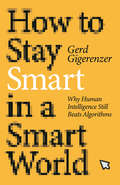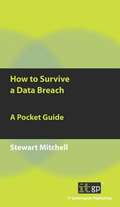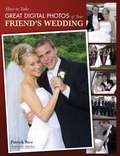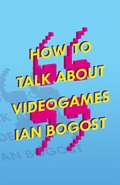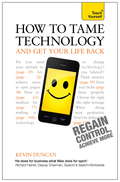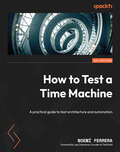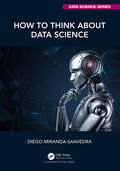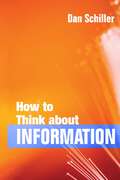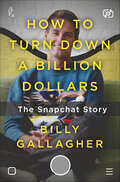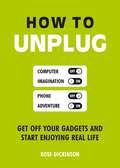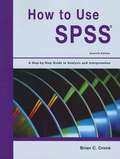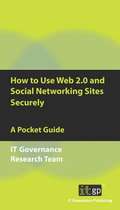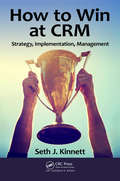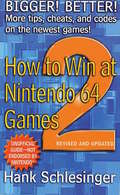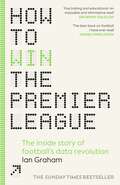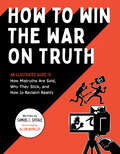- Table View
- List View
How to Stay Smart in a Smart World: Why Human Intelligence Still Beats Algorithms
by Gerd GigerenzerHow to stay in charge in a world populated by algorithms that beat us in chess, find us romantic partners, and tell us to &“turn right in 500 yards.&”Doomsday prophets of technology predict that robots will take over the world, leaving humans behind in the dust. Tech industry boosters think replacing people with software might make the world a better place—while tech industry critics warn darkly about surveillance capitalism. Despite their differing views of the future, they all agree: machines will soon do everything better than humans. In How to Stay Smart in a Smart World, Gerd Gigerenzer shows why that&’s not true, and tells us how we can stay in charge in a world populated by algorithms. Machines powered by artificial intelligence are good at some things (playing chess), but not others (life-and-death decisions, or anything involving uncertainty). Gigerenzer explains why algorithms often fail at finding us romantic partners (love is not chess), why self-driving cars fall prey to the Russian Tank Fallacy, and how judges and police rely increasingly on nontransparent &“black box&” algorithms to predict whether a criminal defendant will reoffend or show up in court. He invokes Black Mirror, considers the privacy paradox (people want privacy, but give their data away), and explains that social media get us hooked by programming intermittent reinforcement in the form of the &“like&” button. We shouldn&’t trust smart technology unconditionally, Gigerenzer tells us, but we shouldn&’t fear it unthinkingly, either.
How to Stop a Hijacking: Critical Thinking in Civil Aviation Security
by Clay W. BilesHijackings and bombings have plagued civil aviation since 1930 and air rage incidents are on the rise. While there is aircraft and inflight training available for air marshals, other first responders receive minimal training on inflight security awareness and protocols. There are no other resources currently available to flight crews or armed first responders that specifically address inflight security and how to address threats of disturbances on airplanes.How to Stop a Hijacking provides readers with fundamental principles on how to think more critically about onboard security threats. The aircraft cabin poses unique environment and security challenges, and first responders can apply security awareness and critical thinking skills to establish a safer environment in the cabin and airport for everyone onboard. The lessons in this book are driven with the central objective of teaching the reader how to counter inflight aggression and maintain tactical control of the cabin. Written by a former federal air marshal instructor, this book looks at the recent rash of air rage incidents and violence on airplanes, in addition to the real and ever-present threat of hijack or potential explosive device.How to Stop a Hijacking is a practical guide that offers methodological and tactically proven strategies for stopping violent acts onboard an aircraft inflight.
How to Survive a Data Breach: A Pocket Guide
by Stewart MitchellData breaches are, for most organizations, a crushing blow to their customers' and staff's confidence in them, to their reputation and brand value, and to the career prospects of senior executives. A data breach may be an even bigger calamity to the individuals whose data has been exposed to Internet criminals, to the press and, possibly, to malicious and ill-wishing acquaintances. Identity theft is a growing problem, and one which is inadequately policed. Individuals whose personal and/or financial data has been breached can find that their credit histories are compromised, and may have to spend years and substantial sums clearing their names. Those organizations that have a tried and tested procedure in place for dealing with data breaches will not only put themselves in a position to obey the current and emerging data breach legislation but, more importantly, will enable themselves to win back some respect from the customers whose data has been breached. This pocket guide provides essential support for organizations tackling this mission. The information is drawn from various regulatory publications, and interviews with security experts, lawyers and software suppliers.
How to Survive a Quarter-Life Crisis: A Comfort Blanket for Twenty-Somethings
by Hattie HamiltonMy 'life goals before 25' when I was 20: mortgage, become an MD or social media sensation, have good hair, have my own sustainable coffee shop, travel to 98 countries.My life goals on the eve of my 25th birthday: afford my rent without getting overdrawn this month, get at least two likes on my Instagram post on my new shoes, remember to pluck nose hairs before work, stop mislaying my refillable coffee cup, visit my parents once a month.Is it just me, or does everyone else have their shit together?Believe me, you’re not alone! If you’re having sleepless nights about your latest social media post, think that you’re a bit of a loser in love, or have a job that you hate (but you need the money and there are no full-time poet positions out there), then this book is your life-jacket and comfort blanket rolled into one sweet package. Learn why you’re not the failure you think you are, and why actually you’re well on your way to being a flawed-but-brilliant grown-up, as this guide helps you navigate your way through the choppy waters of your quarter-life crisis.
How to Take Awesome Photos of Cats
by Andrew MarttilaA fun and practical guide to taking the perfect pics of your cat from the photographer of Cats on Catnip -- a great gift for the feline fanatic in your life. If you or someone you know loves a cat, chances are they love taking pictures of their cat, too. But cats can be tricky little guys to photograph -- they move quickly when you want them to stay still and are sedentary logs when you're going in for an action shot. Add to that all the variables of shooting indoors vs. outdoors, and it can be a difficult job. Enter How to Take Awesome Photos of Cats, where professional cat photographer and popular Instagrammer Andrew Marttila (Cats on Catnip, Shop Cats of New York) walks you through all the steps you need to know to take perfect photos of your favorite feline. This lighthearted, gifty guide includes dozens of photos and shares practical information for both amateur photographers and experts alike, all told in a fun, accessible, and lighthearted way. Whether you're looking to take better photos with your phone or you're trying to master the settings on your digital camera, this is the book that tells you everything you need to know to take awesome snaps of cats.
How to Take Great Digital Photos of Your Friend's Wedding
by Patrick RiceArmed with a digital camera, wedding attendees can create snapshots of the their friend's big day with the camera, lighting, posing, and composition skills taught in this step-by-step manual. Beginning with a discussion of digital capture basics and how to ensure the best possible exposure by selecting the appropriate ISO settings, photographers learn how to create the setting that produces the best results under any lighting conditions. Posing is also covered so that, armed with some general principles and strategies, amateur photographers can greatly improve their sense of portraiture. Sections on unusual situations teach readers how to make the best of mixed lighting conditions, flatter subjects, avoid exposure problems, and use the flash indoors; while tips on using Adobe Photoshop Elements help photographers give their photographs that professional edge.
How to Talk about Videogames (Electronic Mediations #47)
by Ian BogostVideogames! Aren&’t they the medium of the twenty-first century? The new cinema? The apotheosis of art and entertainment, the realization of Wagnerian gesamtkunstwerk? The final victory of interaction over passivity? No, probably not. Games are part art and part appliance, part tableau and part toaster. In How to Talk about Videogames, leading critic Ian Bogost explores this paradox more thoroughly than any other author to date.Delving into popular, familiar games like Flappy Bird, Mirror&’s Edge, Mario Kart, Scribblenauts, Ms. Pac-Man, FarmVille, Candy Crush Saga, Bully, Medal of Honor, Madden NFL, and more, Bogost posits that videogames are as much like appliances as they are like art and media. We don&’t watch or read games like we do films and novels and paintings, nor do we perform them like we might dance or play football or Frisbee. Rather, we do something in-between with games. Games are devices we operate, so game critique is both serious cultural currency and self-parody. It is about figuring out what it means that a game works the way it does and then treating the way it works as if it were reasonable, when we know it isn&’t.Noting that the term games criticism once struck him as preposterous, Bogost observes that the idea, taken too seriously, risks balkanizing games writing from the rest of culture, severing it from the &“rivers and fields&” that sustain it. As essential as it is, he calls for its pursuit to unfold in this spirit: &“God save us from a future of games critics, gnawing on scraps like the zombies that fester in our objects of study.&”
How to Talk to Your Computer (Let's-Read-and-Find-Out Science 2)
by Seymour SimonRead and find out about the basics of computer language in this colorfully illustrated nonfiction picture book.Have you ever wondered how to get a computer to do something? First you need to speak in a way it can understand! Read and find out all about how to talk to your computer in this updated edition with new illustrations and simple engaging text that introduces conditions, loops, and functions.How to Talk to Your Computer comes packed with visual aids like charts, sidebars, an infographic, and a computer-less coding activity. This updated 2019 edition was vetted by Dr. Justin Solomon, Assistant Professor at Massachusetts Institute of Technology.This is a clear and appealing science book for early elementary age kids, both at home and in the classroom. It's a Level 2 Let's-Read-and-Find-Out, which means the book explores more challenging concepts for children in the primary grades. The 100+ titles in this leading nonfiction series are:hands-on and visualacclaimed and trustedgreat for classroomsTop 10 reasons to love LRFOs:Entertain and educate at the same timeHave appealing, child-centered topicsDevelopmentally appropriate for emerging readersFocused; answering questions instead of using survey approachEmploy engaging picture book quality illustrationsUse simple charts and graphics to improve visual literacy skillsFeature hands-on activities to engage young scientistsMeet national science education standardsWritten/illustrated by award-winning authors/illustrators & vetted by an expert in the fieldOver 130 titles in print, meeting a wide range of kids' scientific interestsBooks in this series support the Common Core Learning Standards, Next Generation Science Standards, and the Science, Technology, Engineering, and Math (STEM) standards. Let's-Read-and-Find-Out is the winner of the American Association for the Advancement of Science/Subaru Science Books & Films Prize for Outstanding Science Series.
How to Tame Technology and Get Your Life Back: Teach Yourself
by Kevin DuncanTechnology can be a wonderful thing. It can also be a curse when it overwhelms us. If your phone, computer or other devices are beginning to rule your life, then you need help. We don't have to be ruled by our machines. It's time for us humans to fight back. 'How to Tame Technology' tells you exactly what to do, practical tips and simple things that you can do to regain control. Take the test and find out just how addicted you are - then learn how to cure yourself. 'I can't talk now, I'm on the phone' For those of us suffering from technological overload, it's time to pause and think. Author and Plain English commentator Kevin Duncan has trained and advised some of the UK's top companies, including Saatchi & Saatchi and Shell, in how to cope with all this. This thought-provoking book grapples with just how addicted we have become to technology and offers a set of ideas to help wean us off our technological drugs and lead a more fulfilling life. It looks briefly at how we got here, tests you on how serious your condition is and then offers real solutions, including rapid sequential tasking (v multitasking), communicating concisely, using the best method of communication for the job, all while retaining your sense of humour and enthusiasm. 'Every page is a prompt to imagine things differently. A handbook for these challenging times ahead.' Mark Earls, author of Herd  'He does for business what Nike does for sport.' Richard Hytner, Deputy Chairman, Saatchi & Saatchi Worldwide  'Anyone who owns a mobile should have this on their shelf.' Robert Ashton, author The Life Plan
How to Test a Time Machine: A practical guide to test architecture and automation
by Noemi Ferrera Joe ColantonioRev up your career with powerful project enhancements using this comprehensive guide to test architectures and methodologies applicable to every area of testingPurchase of the print or Kindle book includes a free PDF eBookKey FeaturesExplore the full test architecture spectrumDiscover a range of challenging automation applications with real-world scenariosLearn with easy-to-follow start-up examples including DevOps for testing, AI, XR, and cloudBook DescriptionFrom simple websites to complex applications, delivering quality is crucial for achieving customer satisfaction. How to Test a Time Machine provides step-by-step explanations of essential concepts and practical examples to show you how you can leverage your company's test architecture from different points in the development life cycle.You'll begin by determining the most effective system for measuring and improving the delivery of quality applications for your company, and then learn about the test pyramid as you explore it in an innovative way. You'll also cover other testing topics, including cloud, AI, and VR for testing.Complete with techniques, patterns, tools, and exercises, this book will help you enhance your understanding of the testing process. Regardless of your current role within development, you can use this book as a guide to learn all about test architecture and automation and become an expert and advocate for quality assurance.By the end of this book, you'll be able to deliver high-quality applications by implementing the best practices and testing methodologies included in the book.What you will learnIdentify quality maturity levels and processes to step up your product qualityDevelop the ability to think outside the box when testing methodologiesExamine the various types of tests and their applications from an unconventional perspectiveUnderstand how to apply different technologies to the testing processPractice and polish your testing skills with practical code exercisesExpedite your career growth with quality assuranceWho this book is forThis book is for test owners, developers, managers, manual QAs, SDETS, team leads, and systems engineers who wish to get started or improve the current QA systems. Test owners looking for inspiration and out-of-the-box solutions for challenging issues will also find this book useful.
How to Think About Algorithms
by Jeff EdmondsThis textbook, for second- or third-year students of computer science, presents insights, notations, and analogies to help them describe and think about algorithms like an expert, without grinding through lots of formal proof. Solutions to many problems are provided to let students check their progress, while class-tested PowerPoint slides are on the web for anyone running the course. By looking at both the big picture and easy step-by-step methods for developing algorithms, the author guides students around the common pitfalls. He stresses paradigms such as loop invariants and recursion to unify a huge range of algorithms into a few meta-algorithms. The book fosters a deeper understanding of how and why each algorithm works. These insights are presented in a careful and clear way, helping students to think abstractly and preparing them for creating their own innovative ways to solve problems.
How to Think about Data Science (Chapman & Hall/CRC Data Science Series)
by Diego Miranda-SaavedraThis book is a timely and critical introduction for those interested in what data science is (and isn’t), and how it should be applied. The language is conversational and the content is accessible for readers without a quantitative or computational background; but, at the same time, it is also a practical overview of the field for the more technical readers. The overarching goal is to demystify the field and teach the reader how to develop an analytical mindset instead of following recipes. The book takes the scientist’s approach of focusing on asking the right question at every step as this is the single most important factor contributing to the success of a data science project. Upon finishing this book, the reader should be asking more questions than I have answered. This book is, therefore, a practising scientist’s approach to explaining data science through questions and examples.
How to Think about Information
by Dan SchillerIt is common wisdom that the U.S. economy has adapted to losses in its manufacturing base because of the booming information sector, with high-paying jobs for everything from wireless networks to video games. We are told we live in the Information Age, in which communications networks and media and information services drive the larger economy. While the Information Age may have looked sunny in the beginning, as it has developed it looks increasingly ominous: its economy and benefits grow more and more centralized--and in the United States, it has become less and less subject to democratic oversight. Corporations around the world have identified the value of information and are now seeking to control its production, transmission, and consumption. In How to Think about Information, Dan Schiller explores the ways information has been increasingly commodified as a result and how it both resembles and differs from other commodities. Through a linked series of theoretical, historical, and contemporary studies, Schiller reveals this commodification as both dynamic and expansionary, but also deeply conflicted and uncertain. He examines the transformative political and economic changes occurring throughout the informational realm and analyzes key dimensions of the process, including the buildup of new technological platforms, the growth of a transnationalizing culture industry, and the role played by China as it reinserts itself into an informationalized capitalism.
How to Turn Down a Billion Dollars: The Snapchat Story
by Billy Gallagher"In the grand tradition of Ben Mezrich's The Accidental Billionaires (2009)... an engaging look into a fascinating subculture of millions." —Booklist"Breezy...How to Turn Down a Billion Dollars ably if uncritically chronicles the short history of a young company catering to young users, with a young chief executive, and reveals, intentionally or not, the limitations that come with that combination." —Wall Street JournalThe improbable and exhilarating story of the rise of Snapchat from a frat boy fantasy to a multi-billion dollar internet unicorn that has dramatically changed the way we communicate.In 2013 Evan Spiegel, the brash CEO of the social network Snapchat, and his co-founder Bobby Murphy stunned the press when they walked away from a three-billion-dollar offer from Facebook: how could an app teenagers use to text dirty photos dream of a higher valuation? Was this hubris, or genius? In How to Turn Down a Billion Dollars, tech journalist Billy Gallagher takes us inside the rise of one of Silicon Valley's hottest start-ups. Snapchat developed from a simple wish for disappearing pictures as Stanford junior Reggie Brown nursed regrets about photos he had sent. After an epic feud between best friends, Brown lost his stake in the company, while Spiegel has gone on to make a name for himself as a visionary—if ruthless—CEO worth billions, linked to celebrities like Taylor Swift and his wife, Miranda Kerr. A fellow Stanford undergrad and fraternity brother of the company’s founding trio, Gallagher has covered Snapchat from the start. He brings unique access to a company Bloomberg Business called “a cipher in the Silicon Valley technology community.” Gallagher offers insight into challenges Snapchat faces as it transitions from a playful app to one of the tech industry’s preeminent public companies. In the tradition of great business narratives, How to Turn Down a Billion Dollars offers the definitive account of a company whose goal is no less than to remake the future of entertainment.
How to Unplug: Get Off Your Gadgets and Start Enjoying Real Life
by Ross DickinsonDo you feel like a slave to your smartphone? If it seems like you’ve become a junkie to modern technology, this sanity-saving collection of ideas will motivate you to get more out of life. Full of suggestions to help you unwind and reconnect with the world around you, How to Unplug is a handbook for refreshing yourself in the digital age.
How to Use HTML 3.2
by Scott Arpajian Robert MullenA comprehensive, easy-to-use guide to html 3.2, the language of the worldwide web. If you're an aspiring web page author, an old hand or just curious about how it all works, this book is for you.
How to Use Microsoft® Excel®
by Joseph M. ManzoHow to Use Microsoft® Excel® The Careers in Practice Series is an textbook appropriate for a course covering Microsoft Excel at a beginner to intermediate level. It is geared toward and will be accommodating for students and instructors with little to no experience in using Microsoft Excel. However, the approach is not at the expense of relevance. How to Use Microsoft® Excel® The Careers in Practice Series approaches Excel from the perspective of making personal and professional quantitative decisions. Personal decisions include big purchases such as homes and automobiles, savings for retirement, and personal budgets. Professional decisions include budgets for managing expenses, merchandise items to markdown or discontinue, and inventory management.
How to Use Microsoft® Excel® version 1.1
by Joseph M. ManzoHow to Use Microsoft® Office Excel® The Careers in Practice Series V. 1.1 is an textbook appropriate for a course covering Microsoft Excel at a beginner to intermediate level. It is geared toward and will be accommodating for students and instructors with little to no experience in using Microsoft Excel. However, the approach is not at the expense of relevance. How to Use Microsoft® Excel® The Careers in Practice Series approaches Excel from the perspective of making personal and professional quantitative decisions. Personal decisions include big purchases such as homes and automobiles, savings for retirement, and personal budgets. Professional decisions include budgets for managing expenses, merchandise items to markdown or discontinue, and inventory management.
How to Use SPSS Statistics: A Step-By-Step Guide to Analysis and Interpretation
by Brian C. CronkIBM SPSS Statistics is designed to perform a wide range of statistical procedures. As with any other powerful program for the computer, there are certain conventions and techniques that must be mastered for efficient use of the software and to obtain consistently correct answers. By providing detailed, step-by-step guidance illustrated with examples, this book will help you attain such mastery.
How to Use Web 2.0 and Social Networking Sites Securely
by It Governance Research TeamAt its simplest, Web 2. 0 is the term used to describe the second generation of web technologies, including social networking sites, blogs and wikis, all of which enable the webWeb to be used in a different, more interactive, way than before. These technologies also enable users to connect with a very large number of people in a short period of time at low cost. The use of Web 2. 0 technologies has also spawned new business models and enabled improved collaboration, knowledge sharing and communication within organisations. At the same time, however, Web 2. 0 technologies bring greater security risks for their fast growing universe of users. The number of risks is also growing exponentially. The challenge for businesses, therefore, is to find ways of enabling their users to use Web 2. 0 technologies whilst minimising the risks. Given the widespread use of Web 2. 0 technologies and their impact in terms of the number and types of incidents and the cost of them, controlling Web 2. 0 risks needs
How to Win at CRM: Strategy, Implementation, Management
by Seth KinnettThis book provides clarity and guidance on effective strategy, implementation and management of CRM. It explores both the conceptual and cultural context of CRM initiatives along with the particulars of CRM system implementation and management. In order to provide this clarity, it surveyed the existing academic publications surrounding CRM, sales force automation, and related topics within information systems literature. The book supplements this research with insights from CRM experts to provide a robust picture of the CRM landscape and how to improve it no matter what role you play within your organization. This book is for everyone who wants to achieve CRM success.
How to Win at Nintendo 64 Games 2: Bigger! Better! More Tips, Cheats, and Codes
by Hank SchlesingerThis unofficial guide offers up-to-date hints to help fanatics as well as casual players win at N64 video games consistently. Each chapter contains basic information, such as ESRB ratings, characters, themes, and specific ways to score. Nintendo 64 games covered include WWF WarZone, NFL Blitz, Super Mario 64, and much more.
How to Win the Premier League: The Sunday Times Bestselling Inside Story of Football's Data Revolution
by Ian GrahamTHE SUNDAY TIMES BESTSELLER'The best book on football I have ever read' Daniel Finkelstein'Fascinating and educational. An enjoyable and informative read' Sir Kenny Dalglish'Deserves a place among the great modern books on football' Sam Wallace, chief football writer, Telegraph______________________________The insider account of the data revolution that has swept through the modern football world written by one of its key architects, Ian Graham.Between 2012 and 2023, Ian Graham worked as Liverpool FC's Director of Research. His tenure coincided with the club’s greatest period of success since the 1980s, including winning the Premier League in 2020 – Liverpool’s first league title after an agonising three decades.Here for the first time, Graham reveals the fascinating data that informed some of the club’s most pivotal moments of the past decade, from the appointment of Jurgen Klopp as manager in 2015 to the signing of Mohamed Salah in 2017. Along the way, he shares groundbreaking insight into the modern game, including how a season largely played behind closed doors transformed our understanding of home team advantage, or why the GOAT (greatest of all time) might not be who you think. And, in a game that is increasingly dominated by an elite few, Graham charts a path for the future where a data-savvy competitor will always find the edge.______________________________'A fascinating, witty and remarkably insightful account of Liverpool's reinvention and a clear-eyed, detailed explanation of the inner workings of modern football. Nobody is better qualified to tell either of those stories than Ian Graham, who stands as one of the most (quietly) significant figures in the recent history of the club and the sport' Rory Smith, author of Expected Goals and Chief Soccer Correspondent, New York Times'Never before has the data revolution in football been described so well from the inside.' Christoph Biermann, author of Football Hackers‘How to Win the Premier League gives you three books for the price of one: a book about all of the silly inefficiencies plaguing European football, a book about what it's like to be empowered to use outside-the-box thinking to help turn your boyhood club into the best team in the world, and a book about how football actually works. If he really wanted to, Ian could easily put me out of a job.’Ryan O’Hanlon, author of Net Gains and staff writer ESPN*A Sunday Times bestseller August 2024
How to Win the War on Truth: An Illustrated Guide to How Mistruths Are Sold, Why They Stick, and How to Reclaim Reality
by Samuel C. SpitaleMade to Stick by Chip Heath meets Thing Explainer by Randall Munroe in this illustrated guide to navigating today&’s post-truth landscape, filled with real-world examples of disinformation campaigns.The average person receives 4,000 to 10,000 media messages a day. It&’s no wonder we struggle to separate the news from the noise and fact from fiction--but in these unprecedented times, it&’s essential to democracy that we do. For anyone struggling to figure out how to live--and vote--their values, How to Win the War on Truth is here to help. You&’ll learn: • The history of propaganda, from Edward Bernays to Fox News • Why simple messages are so powerful • How social messaging creates unconscious biases • Who profits from propaganda • How propaganda is manufactured and delivered directly to you Filled with real-world examples of disinformation campaigns that impact every citizen and clever illustration, How to Win the War on Truth will help you see the world with clear eyes for the first time.
How to Zoom Your Room: Room Rater's Ultimate Style Guide
by Claude Taylor Jessie BahreyThe ultimate users' guide to curating your Zoom background from Room Raters, Twitter's foremost experts in on-screen décor. From the virtual office aficionados and Twitter superstars who brought the world the dreaded embarrassment of &“cord violations,&” comes a fun, informative guide for everyone who now finds themselves having to endure the endless onslaught of digital meetings and calls. Packed with beautiful how-to illustrations that demonstrate visually stunning set-ups and tips from celebrity zoom rooms, Room Rater packs an amusing punch while offering advice on how to up your game and not be embarrassed by your surroundings. Included in the book are examples from TV host Jonathan Capehart, former Obama advisor Valerie Jarrett, Senator Mazie Hirono, historian Michael Beschloss who takes readers on a tour of historic presidential rooms, and many more. Chockfull of practical advice that speaks directly to the home office user, the book offers guidance on how to create good lighting, use the perfect camera angle, get rid of clutter, add aesthetically pleasing touches, and avoid appearing as if you are in a hostage video. Whether we like it or not, the remote workplace is here to stay and this book serves as an essential guide to navigating that new normal. It&’s a valuable tool for everyone who wants to appear professional, competent, and composed.
